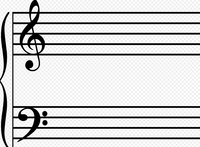








Staff, also spelled stave ,Guido d’Arezzo in the notation of Western music, five parallel horizontal lines that, with a clef, indicate the pitch of musical notes. The invention of the staff is traditionally ascribed to Guido d’Arezzo in about the year 1000, although there are earlier manuscripts in which neumes (signs from which musical notes evolved) are arranged around one or two lines in order to orient the singer. Guido used three or four lines of different colours. A four-line staff is still used to notate plainchant.
History
Guido of Arezzo was a music theorist of the Medieval era. He is regarded as the inventor of modern musical notation (staff notation) that replaced neumatic notation; his text, the Micrologus, was the second-most-widely distributed treatise on music in the Middle Ages (after the writings of Boethius).
The standard five-line staff appeared in about 1200 in polyphonic music. Some 16th-century keyboard music used staves of more lines. Modern keyboardists play from two combined staves: one for the right hand in treble clef, and one for the left in bass clef. A precise staff notation made possible composition of the complex polyphonic works that characterize Western art music.